![]()
Obituary
Rudolf H. DRENT (Los Angeles, USA 1937 – 2008 Groningen, NL).
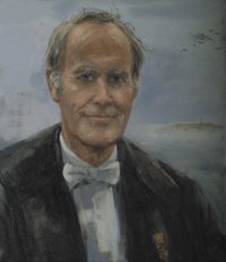 |
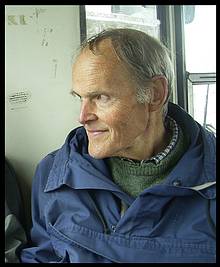 |
| Painting by Carla Rosenberg made in 2002. | Picture by Helmut Kruckenberg. |
On 9 September 2008 Rudi Drent died. Rudi was teaching Animal Ecology at the University in Groningen (the Netherlands) from 1972-2002, and beyond.
Because of his special interest in geese, I have asked goose biologists to share their memories of this inspiring man on the website of the Goose Specialist Group.
Rudi really lifted goose biology by intertwining it with ornithology, or even better, ecophysiology at large. He loved to work out in the field and he loved to work hard. Apart from that, he had a special interest in islands. In British Columbia Mandarte island, in the Old World the Dutch island of Schiermonnikoog, or a larger island like Spitsbergen were his favourite places to be. He knew the literature, outwitted almost everybody by his fast and constructive way of thinking, and was particularly known for his clear comparisons. When he was lecturing in Flanders one day, he wanted to explain how important female body mass was for breeding success in Brent Geese. As we now all know, the body mass female geese achieve just before departure from the spring staging areas in the temperate zone is crucial for reproduction in the high arctic. Female body condition, when no weights are easily obtainable, is often expressed as Abdominal Profile Index (API), and heavy goose bottoms score highest in this index. While in Flanders he named this index the Rubens-index, and the audience immediately understood what he meant. No one in that audience will ever forget about the Rubens-index.
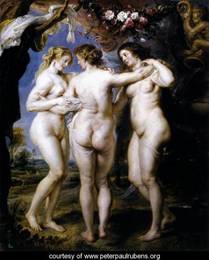
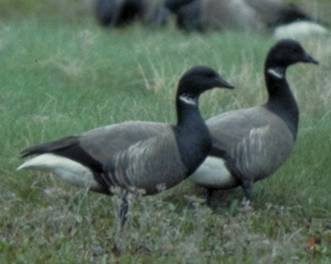
The Rubens-index: As you can see on this picture of The Three Graces as painted by the Flemish painter Peter Paul Rubens in 1639 the wealthy bodies of these Graces are directly comparable to what a good Brent female looks like in May (the bird on the right is the female, closely followed and guarded by her mate).
The book ‘Seeking Nature’s Limits, ecologists in the field’ (2005) shows how influential Rudi’s teaching was. This book originally appeared in Dutch under the title ‘Onvrije Natuur’, edited by J.M. Tinbergen, J.P. Bakker and T. Piersma but was carefully translated into English by Rudi himself. It contains 320 pages with 40 contributions of his students and other people that where stimulated by him. Seeking Nature's Limits |
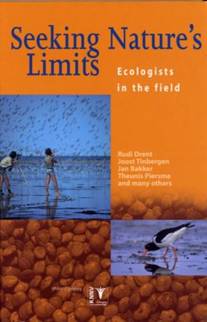 |
Below you can read the statements by goose biologists from the New and Old World honouring this great man.
Compilation of statements by goose biologists to commemorate Rudi's work.
From the start of my career in wildlife biology in the early 1960s, Rudi's work has been an inspiration to me. At that time it was his doctoral work on gulls along the British Columbia coast that held my attention. We met for the first time at a meeting in Colorado in the early 1970s, but it was mainly during a visit to his research station in the Netherlands in 1975 that I came to recognize the depth of his qualities as a person as well as a scientist. Since then we have met at many other meetings of the former International Bureau of Waterfowl Research and of the North American Arctic Goose Group. Rudi's publications speak for themselves: precise, concise, and written in a relaxed and informative way, with catching titles that set the scene for his messages. To my knowledge, he was the first to add artwork to his graphs, adding an element of pleasure for his readers. But it was Rudi's personal attributes that struck me most. At meetings he showed a remarkable knack of intervening in a way that was so sincerely constructive - entirely devoid of intimidation - that contributed strongly to relaxed and productive exchanges. Certainly, living continents apart, our meetings must not have been all that frequent - it must have been the quality of those encounters that make the friendship stand out so strongly in my mind. He will be deeply missed.
Austin Reed
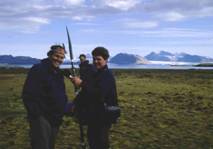 I managed to find a old slide of Rudi and Nigel Jarrett of WWT during fieldwork in Svalbard in 1989.
I managed to find a old slide of Rudi and Nigel Jarrett of WWT during fieldwork in Svalbard in 1989.
Jeff Black in the distance. Not sure what was going on, but Rudi had us all laughing !
Carl Mitchell
Rudi shaped multiple aspects in my work and beyond. As for goose biology, it was his students that showed me how to get on to my hands and knees to examine goose-plant interactions in intimate detail to better understand why the birds chose to come and go to specific foraging patches. On a larger scale of the flyways Rudi was among those that encouraged me to imagine the 'green wave of digestibility' that shaped global migrations. Perhaps more importantly, on visiting Groningen and Schiermonnikoog he showed me an educational model of hands-on experiential learning for students (and professors) that I now strive to provide at my own university. I enjoyed my time with Rudi at his home, in the classroom, in town and most of all - on the tundra.
Jeff Black
Rudi Drent was one of the brightest and most stimulating people I have ever met and I always gained a lot from discussions with him. His lively and original mind could always see new ways to look at an ecological problem and he was always ready to offer constructive criticism, tempered with his characteristic humour. I was most impressed by his exceptional ability to inspire enthusiasm among his students. When I first visited his field sites, I could hardly believe that anyone could persuade undergraduates to spend whole days in the rain measuring grass leaves or counting duck droppings, and then take part in a vigorous discussion session in the evening! Whole generations of students and researchers will look back fondly on their contact with Rudi. He will be greatly missed.
Ian Patterson.
I first met Rudi Drent in the spring of 1972, when he was over at the Groningen University to work on a joint paper with Prof. G.P.Baerends on “The Hering gull and its egg”. Rudi was to become lecturer in Animal Ecology that next winter of 1972-73, and Prof. Baerends warmly recommended to him my plan to study the winter ecology of Barnacle Geese. Together with Jan Hulscher we went out to the island of Schiermonnikoog in March 1972 and it took me very little time to convince Rudi that geese, and in particular the many droppings they left behind on the saltmarsh, were a promising item for fieldwork.
That winter Kees Canters, a fellow student engaged in this plan, and I were initially supervised by Jan Hulscher and worked in the newly reclaimed Lauwersmeer area, a haven for Barnacle Geese at that time. However, in December 1972 when Rudi finally came over from Vancouver, the geese had left this area having eaten out all Salicornia. Then we switched over with the geese to the island of Schiermonnikoog. Rudi had this special thing with islands, as I learned later. On Schiermonnikoog his special way of stimulating fieldworkers invigorated us tremendously. Every evening after a long day’s fieldwork the newly collected data were immediately plotted on graphs, and we started to work out how much time these geese spent feeding, and worked out a way to estimate their daily food intake, and the carrying capacity of the grasslands for wintering geese. As a teacher and lecturer he was outstanding, always choosing just the right words, almost like a poet. For me it was always a joy to listen when he was lecturing.
Bart Ebbinge
Rudi Drent will be missed by all in the field, but especially by those of you closest to him who benefited from regular interaction. I wish I had known him a little better. I had a vicarious relationship through Bob Jefferies, who talked about him much and passed on many ideas.
Ken Abraham
Sadly, Rudi Drent never visited La Pérouse Bay on the Hudson Bay coast, but his influence on the direction of studies of goose herbivory at that intensive study site was enormous. I remember Fred Cooke telling me when I started work at LPB, “You should look at the papers of Rudi Drent and his colleagues”. They were gems, well crafted and insightful and they provided a robust template to study overcompensation of plant growth in response to goose grazing which preoccupied us in the late 1970’s and the early 1980’s. To this day, I reread his papers and look for the latest, much as if he is a leading writer. I first met Rudi at a goose meeting in Québec at that time. There was an immediate meeting of minds and I remember discussing nitrogen nutrition in plants and animals and resource acquisition at a very late hour over a bottle of excellent red wine. As always, he took copious notes and those many notebooks must contain a treasure trove of unpublished insights. Over the years our friendship and scientific exchanges grew, particularly in relation to similarities and differences between goose herbivory and plant responses at LPB, Schiermonnikoog, Spitzbergen and the Pechora Delta that resulted in a joint paper together with Jan Bakker . He was fascinated by the destructive foraging at LPB, positive and negative feedbacks and alternative stable states, and it is only in the last decade or so that elements of this destructive herbivory also have been detected on Spitzbergen as goose numbers have risen. He and his students in conjunction with Jan Bakker explored the outcome of facilitation and competition between herbivores with considerable success at Schiermonnikoog and I often remarked to him that I wished the animal interactions at LPB were more complex, thereby providing the opportunity for comparative facilitation studies between sites. Relatively simple systems have their limitations!
I was given with a visiting professorship at Haren which Rudi and Jan were instrumental in obtaining for me. It was a wonderful time. Often Rudi and I were closeted in my small office for an hour or more where we would argue about the consequences of migratory connectivity in relation to multiple migration pathways and capital versus income breeders and plant availability. This was very much the era of “the Green Wave Hypothesis” but it was an even bet whether Rudi would show up on the appointed day! Somehow this uncertainty amplified the intensity and earnestness of our discussions when they occurred for his agile mind provided a wealth of insights. He had that unusual ability to sum up a complex situation with a turn of phrase that captured the essence of the matter as the titles of many of his papers show. A paper duly appeared from these deliberations.
He has enriched the lives of us all in so many ways and nurtured a new generation of goose biologists who, like him, have a broad scientific perspective. His legacy is very much alive and flourishing, which is a fitting tribute to his endeavours.
Bob Jefferies
Rudi did so much for avian ecology and goose biology in particular. His contribution was massive and he will be sorely missed. I first met him at the Moscow JOC in 1982.
Fred Cooke
I met Rudi halfway through what is now a 40 year adventure working with snow geese at la Pérouse Bay. My approach to field work and my thoughts about geese were changed forever by that meeting. His view of the problems associated with geese were broad and his enthusiasm for taking a holistic approach to their solution was infectious. He especially encouraged me to add physiology and energetics to my thinking and to look beyond what was already known about what we thought was a well-understood system. To his credit, he managed to do this through much resistance on my part - ever gentle but convincingly logical.
Global goose biology was made better by his too-brief presence.
Rocky F. Rockwell - American Museum of Natural History
In memory of Rudi Drent
I was happy to work with Rudi, be it only for two field seasons - in 2005 and 2007 in Tobseda, Kolokolkova Bay. But it was an experience I will never forget. Rudi was so patient explaining any scientific thing, so accurate in showing me birds or grasses. All the time I felt that I worked with a real master.
But what is probably even more important for me is that Rudi was not only an excellent teacher and an outstanding scientist. First of all he was a very clever and erudite man, very sensitive to human tragedies. It was so pleasant after a hard working day in the field to sit around the table and discuss anything from the literature of Tolstoy to some interesting details of African culture, to listen about the history of the Netherlands or about Napoleonic times. It was so hurting to listen about human fates in time of Second World War, hurting because Rudi felt people’s tragedies as his personal.
Rudi was just really a good man. Hard to believe that he is not with us any more.
I will really miss him…
Olya
Ольга Покровская (Olga Pokrovskaya)
Rudi’s impact on my goose (and wader) work.
At conferences, the originality and liveliness of Rudi’s own papers and contributions to the discussions always added zest. He was also a master at summarising the proceedings, managing to find penetrating, yet encouraging, things to say even about our weaker efforts.
In private discussions, you could fly the wildest and vaguest ideas past him without them being torn to shreds. Theunis said it best, in the massive “Postscript and acknowledgements” section of his doctoral thesis:.”the most witty and imaginative supervisor one could have. Never a wild idea that Rudi would not make wilder.”
Above all, he was a kind and generous friend, especially helpful when one was depressed or saddened by some failure or misfortune.
Though now we shall have to manage without him, all of us whose lives were brightened by him will remain grateful for his inspiration, and for the generous hospitality that Nel and he gave us at Paterswolde.
Hugh Boyd.
I was never one of Rudi's close collaborators, but I still feel that I owe him an awful lot. Not only was "the prudent parent" one of the key references in my PhD thesis, but we also discussed issues from goose ecology to German history on several occasions over the last twenty years. Goose meetings without Rudi? Unthinkable. I've never been in the field with him (it just didn't work out that way), but often wished that the chance might still come up one day. Too late now.
Barbara Ganter
I met Rudi first time at the Western Palearctic Goose conference that was held in Kleve in Germany in February 1989. I was a young masters student in goose biology then, and Rudi at the conference bus excursion to goose sites in Lower Saxony decided to sit with me, and discuss what my research on Light-bellied Brent Geese was about. I have seen him doing this so many times since then, and this is a memorable picture of him always wanting to stimulate progress in waterbird research at all levels, instead of just talking with other top-Professors at meetings. An approach all experienced researchers should continue to duplicate, for the benefit of future generations, waterbird research and conservation - issues Rudi had at the top of his life mission.
Preben Clausen, NERI, Denmark
We are fortunate to meet many impressive and arresting people in the course of our working and leisure lives, but it is very rare indeed to meet a man as gifted as Rudi Drent. Rudi was simply one of the best. He was possessed of sharp intelligence, unbound knowledge and outstanding wisdom, yet to be touched by the potent benefit of his generous friendship, guidance and support showed him to be very much more. His inheritance will be written large in the vast achievements of his very many outstanding students that continue to bear the torch lit by his inspiration. Rudi was a supreme stimulus and catalyst to all who showed commitment and it is impressive to think that for more than 25 years he led and breathed fire into the Centre for Ecology and Evolutionary Studies at the University of Groningen. He knew not just how to inspire, but how important it was to exploit this trait. From that group poured more talent than most institutes could hope to muster in the space of a frenetic generation, making a substantial impression on our world and the way that we view the decision-making made by animals within the constraints set by their biology and environment. That inspiration produced a succession of truly outstanding research and students, starting with his own work on optimisation of avian parental investment and running far into our future as the raw metal of his ideas are forged and refashioned into new work carried on by his many followers. Yet even this legacy feels so diminished in the world without the man. How can you replace his remarkable company, his energy, his quick-fire hilarious humour, his wicked glint, his warmth? I well remember being bewitched by my first Rudi presentation. His sparkling wit and crackling pace, the intensity of ideas and the grasp of the unreachable, all sewn together with striking imagery and data points that sometimes did not always quite fit the theory. These were all things that made him a remarkable performer and supreme communicator, a truly charismatic and extraordinary man, rousing and swirling, extravagant and light, yet focussed and concise. All born of a simple love of nature, a passion for living things and the need to better understand. He seemed never happier than sailing his boat on the Lauwersmeer counting birds and sharing earlier memories from his fearsome memory. Always sharing. He was most comfortable in wellington boots, never more engaging than sharing experiences in the field, never more inspiring than when surrounded by that which he loved: nature. That said, one could not feel more at home than to gather round the cosiest of breakfast tables with Nel, Rudi and the morning papers, although it could be tough keeping up with Rudi discussing the special relationships between Churchill, MacMillan and Kennedy, struggling to name all 28 members of Danmark-Ekspeditionen under Mylius-Erichsen, or picking over the minutiae of Danish domestic politics in a way that made it hard to remember he was neither British nor Danish. His wit and conversation were second to none and never more valued than when he stood up the end of my thesis defence and demanded of NERI’s Director General in front of gathered witnesses: “And I hope that now you will give this man some money to carry on this research…!”. He was a very tidy man. In a recent letter he thanked me for “smooth diplomacy and solid friendship over the years”. I missed the significance at the time, of course, but simply could not be more proud.
Tony Fox
Whilst weeding the garden today I have been thinking about Rudi and could easily write a couple of hundred words.
Myrfyn Owen
This is very sad news indeed and definitely surprising. Rudi had a very distinct (and I believe unusual) ability to make bird behaviour/ecology easy to understand. I really loved the way he wrote and spoke. My first encounter with Rudi was in 1992 at the NA Arctic Goose conference in California, where he gave a wonderful talk on energy balance and the green wave hypothesis. That talk (and resulting paper) influenced my thoughts on the pattern of spring migration by Wrangel Island Snow Geese as well as some recent work on sea ducks and how they ride a "silver wave" of Pacific herring spawn as they move north in spring. My last encounter with Rudi was in the early 2000s when he and Julia Stahl 'guided' me around the island of Schiermonnikoog; I was exhausted by the end of the day but Rudi still had plenty of energy, especially when it came to discussing goose biology. He'll be missed for sure.
Sean Boyd
In 1982, I spend several days together with Rudi Drent in a box 1 * 1 * 1.50 meter, 5 meters above the saltmarsh. This box was located on one of the most pristine wilderness areas of the Netherlands: the eastern point of Schiermonnikoog, close to Willem’s dune. Most hours we were waiting for brent geese to come into the range of our telescope. When this happened, we started reading individually coded rings, immediately followed by registration of foraging behaviour and dominance hierarchy. Over the month of May, I became aware of personalities in geese and about the way they exploited the vegetation. We saw the geese prepare for their breeding season. They became visible thicker every week. The day, we saw the geese take-off in the evening, joining passing flocks flying east, was an emotional highlight.
From that moment onward, I was fascinated by the geese and knew that I wanted to study ecology like this man was doing. Rudi Drent became my teacher into science. He was my perfect coach. He allowed me to find my own way and make my own plans, but he was always creating opportunities and full of suggestions to improve science. He introduced me to other goose researchers both in the Netherlands and abroad and had me cooperate with them. His science was truly international, full of new developments and highly relevant for farmers, hunters and nature conservationists.
Every day, almost every hour, I am still doing something, to which he introduced me the first time.
And I am still loving it!
Last July, at his last lecture in St. Petersburg Russia, he talked about my work, allowing me to stay in the field. In the first week of September, 4 days before his operation we met at his home in Paterswolde. Still a strong mind, but in a body which had lost a lot of strength.
Now I feel an orphan. I will miss him.
Maarten Loonen